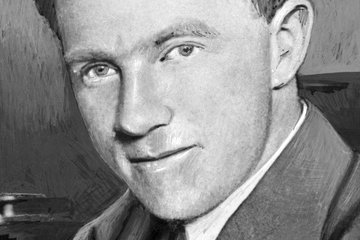Foundation and Early Years
Weimar Republic

The campus was established in 1911, well beyond the gates to Berlin. As the Institutes began to grow in number and employ more people during the 1920s, the lack of service infrastructure on the campus became apparent. What was more, guest scientists were increasingly traveling from abroad. Given the lack of accommodation available in Dahlem and the absence of a central lecture hall on campus, there was clear demand for a central location with guest rooms, catering facilities, event spaces and lecture halls, as well as lounge areas for informal gatherings.
In 1929, the President of the Kaiser Wilhelm Society, Adolf von Harnack, and its Secretary General Friedrich Glum implemented plans for an international clubhouse and guest house. The German Foreign Minister at the time, Gustav Stresemann, lent his support to the project. Harnack and Stresemann shared liberal ideals; both men saw internationalization as the key to the success of the Weimar Republic. As Foreign Minister, Stresemann was striving to reintegrate Germany in the international community following the First World War and was faced with a range of political opponents. Harnack told him that scientists could act as vital cultural ambassadors to support his efforts. On May 7, 1929, Harnack House was opened.
Support for the project also came from the world of industry. The Kaiser Wilhelm Society appealed for donations to fund the House’s interior furnishing. Many prominent commercial enterprises saw research as the motor of innovation and provided significant sums of money. All the same, private individuals from Germany and abroad also made donations.

Harnack House quickly became a key port of call for those working on Dahlem Campus, who appreciated the lunches, the exercise and gymnastics classes in the gym, and the outdoor tennis courts. A swimming pool was also constructed in 1938. In the reading room, hotel guests and Kaiser Wilhelm Institute employees could peruse around 100 domestic and international newspapers.
Yet, the House soon went on to play a role in public life in Berlin. Prominent figures from science and the arts visited Harnack House, as did politicians, diplomats, bankers and industrialists. Guests from Europe and overseas would sometimes stay for several months at a time. For the Kaiser Wilhelm Society, Harnack House was a new and important place to foster communication and maintain networks.
Other institutions also reserved the house as a venue for their events, including the German Academic Exchange Service (DAAD), the Staatliche Museen zu Berlin, and international cultural institutes. Harnack House was a common venue for the German Association of Female Academics (DAB) in particular, as many female scientists were members of the KWG – Lise Meitner among them. Harnack House became a hub in the international network of research, politics and business.
In addition, the House hosted events for the local populace. Prominent scientists gave presentations on their subject areas to interested lay audiences in the lecture hall, thereby laying the foundations for a modern form of science communication. Topics ranged from ornithology to modern nuclear physics, genetics and biochemistry. Lectures were also given on subjects from the social sciences.











